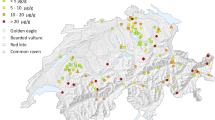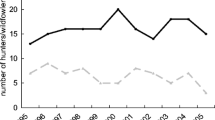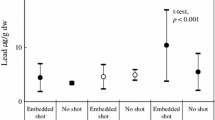Abstract
A serious hazard for avian scavengers is lead poisoning caused by feeding on shot mammalian carcasses containing fragments of lead-based bullets. Both obligate and facultative scavenging species are affected, such as the white-tailed eagle Haliaeetus albicilla for which lead intoxication is a major source of mortality. However, the exploitation of hunter-killed carrion by facultative avian scavenger communities is little studied. As bullet fragments recovered from the intestinal tract of white-tailed eagles were generally small and did not represent the full spectrum of available bullet fragment sizes, the hypothesis arose that this is the result of selective food processing in that eagles avoid the intake of large metal particles. Here, we used an experimental approach to identify lead-exposed species and explore the food processing of white-tailed eagles and other scavengers. We conducted feeding experiments with free-ranging scavengers in six eagle home ranges in northeastern Germany and with six eagles temporarily held in captivity. We provided ungulate carcasses containing non-toxic iron particles of different diameters, simulating bullet fragments, as food source. Primarily, avian scavengers such as ravens, eagles and buzzards exploited the carcasses, indicating them to be exposed to lead fragments and poisoning. With increasing diameter of experimental particles, free-ranging scavengers and captive eagles increased the percentage of particles avoided during feeding. Scavengers almost completely avoided fragments of 8.8 mm diameter. Behavioural observations of captive eagles showed that they detected iron particles predominantly by touching the experimental carcass with their bill tip, suggesting that they use mechanoreceptors to judge food quality. Our findings indicate that the use of bullets that deform or fragment into particles greater than 9 mm in size, such as numerous lead-free bullets, may prevent metal ingestion and poisoning in avian scavengers.



Similar content being viewed by others
References
Bang BG, Cobb S (1968) The size of the olfactory bulb in 108 species of birds. Auk 85:55–61
Blázquez M, Sánchez-Zapata JA, Botella F, Carrete M, Eguía S (2009) Spatio-temporal segregation of facultative avian scavengers at ungulate carcasses. Acta Oecol 35:645–650
Brewer L, Fairbrother A, Clark J, Amick D (2003) Acute toxicity of lead, steel, and an iron-tungsten-nickel shot to mallard ducks (Anas platyrhynchos). J Wildl Dis 39:638–648
Cortés-Avizanda A, Selva N, Carrete M, Donázar JA (2009) Effects of carrion pulses on herbivore spatial distribution are mediated by facultative scavengers. Basic Appl Ecol 10:265–272
Craighead D, Bedrosian B (2008) Blood lead levels of common ravens with access to big-game offal. J Wildl Manag 72:240–245
Cunningham SJ, Castro I, Potter MA (2009) The relative importance of olfaction and remote touch in prey detection by North Island brown kiwis. Anim Behav 78:899–905
DeVault TL, Rhodes OE, Jr S, Shivik JA (2003) Scavenging by vertebrates: behavioral, ecological, and evolutionary perspectives on an important energy transfer pathway in terrestrial ecosystems. Oikos 102:224–234
Dias MP, Granadeiro JP, Palmeirim JM (2009) Searching behaviour of foraging waders: does feeding success influence their walking? Anim Behav 77:1203–1209
East M (1988) Crop selection, feeding skills and risks taken by adult and juvenile rooks Corvus frugilegus. Ibis 130:294–299
Fiedler HJ, Rösler HJ (1993) Spurenelemente in der Umwelt. Gustav Fischer Verlag, Jena
Fisher IJ, Pain DJ, Thomas VG (2006) A review of lead poisoning from ammunition sources in terrestrial birds. Biol Conserv 131:421–432
Glutz von Blotzheim UN, Bauer KM (1993) Handbuch der Vögel Mitteleuropas Vol 13 Passeriformes. Aula-Verlag, Wiesbaden
Glutz von Blotzheim UN, Bauer KM, Bezzel E (1971) Handbuch der Vögel Mitteleuropas Vol 4 Falconiformes. Akademische Verlagsgesellschaft, Frankfurt am Main
Gottschaldt K-M (1985) Structure and function of avian somatosensory receptors. In: King AS, McLelland J (eds) Vol 3: Form and function in birds. Academic, London, pp 375–463
Gustafson LA, Cheng H-W, Garner JP, Pajor EA, Mench JA (2007) Effects of bill-trimming Muscovy ducks on behavior, body weight gain, and bill morphopathology. Appl Anim Behav Sci 103:59–74
Halley DJ, Gjershaug JO (1998) Inter- and intra-specific dominance relationships and feeding behaviour of golden eagles Aquila chrysaetos and sea eagles Haliaeetus albicilla at carcasses. Ibis 140:295–301
Hansen AJ (1986) Fighting behavior in bald eagles: a test of game theory. Ecology 67:787–797
Hapke H-J (1988) Toxikologie für Veterinärmediziner. Ferdinand Enke Verlag, Stuttgart
Heinrich B (1988) Winter foraging at carcasses by three sympatric corvids, with emphasis on recruitment by the raven, Corvus corax. Behav Ecol Sociobiol 23:141–156
Helander B, Axelsson J, Borg H, Holm K, Bignert A (2009) Ingestion of lead from ammunition and lead concentrations in white-tailed sea eagles (Haliaeetus albicilla) in Sweden. Sci Total Environ 407:5555–5563
Houston DC (1986) Scavenging efficiency of turkey vultures in tropical forest. Condor 88:318–323
Houston DC (1988) Competition for food between Neotropical vultures in forest. Ibis 130:402–417
Hunt WG, Burnham W, Parish CN, Burnham B, Mutch B, Oaks JL (2006) Bullet fragments in deer remains: implications for lead exposure in scavengers. Wildl Soc Bull 34:167–170
Jackowiak H, Godynicki S (2005) Light and scanning electron microscopic study of the tongue in the white tailed eagle (Haliaeetus albicilla, Accipitridae, Aves). Ann Anat 187:251–259
Kelly ME, Fitzgerald SD, Aulerich RJ, Balander RJ, Powell DC, Stickle RL, Stevens W, Cray C, Tempelman RJ, Bursian SJ (1998) Acute effects of lead, steel, tungsten-iron, and tungsten-polymer shot administered to game-farm mallards. J Wildl Dis 34:673–687
Kenntner N, Tataruch F, Krone O (2001) Heavy metals in soft tissue of white-tailed eagles found dead or moribund in Germany and Austria from 1993 to 2000. Environ Toxicol Chem 20:1831–1837
Kramer JL, Redig PT (1997) Sixteen years of lead poisoning in eagles, 1980-95: an epizootiologic view. J Raptor Res 31:327–332
Krone O, Stjernberg T, Kenntner N, Tataruch F, Koivusaari J, Nuuja I (2006) Mortality, helminth burden and contaminant residues in white-tailed sea eagles from Finland. Ambio 35:98–104
Krone O, Kenntner N, Tataruch F (2009a) Gefährdungsursachen des Seeadlers (Haliaeetus albicilla L. 1758). Denisia 27:139–146
Krone O, Kenntner N, Trinogga A, Nadjafzadeh M, Scholz F, Sulawa J, Totschek K, Schuck-Wersig P, Zieschank R (2009b) Lead poisoning in white-tailed sea eagles: causes and approaches to solutions in Germany. In: Watson RT, Fuller M, Pokras M, Hunt G (eds) Ingestion of lead from spent ammunition: implications for wildlife and humans. The Peregrine Fund, Idaho, pp 289–301
Krone O, Berger A, Schulte R (2009c) Recording movement and activity pattern of a white-tailed sea eagle (Haliaeetus albicilla) by a GPS datalogger. J Ornithol 150:273–280
Krone O, Nadjafzadeh M, Berger A (2013) White-tailed sea eagles (Haliaeetus albicilla) defend small home ranges in north-east Germany throughout the year. J Ornithol 154:827–835
Manly BFJ, McDonald LL, Thomas DL, McDonald TL (2002) Resource selection by animals, 2nd edn. Kluwer Academic Publishers, Dordrecht
Martin GR (1986) Shortcomings of an eagle’s eye. Nature 319:357
Martin P, Bateson P (1993) Measuring behaviour, 2nd edn. Cambridge University Press, Cambridge
Mason JR, Clark L (2000) The chemical senses in birds. In: Whittow GC (ed) Strukie’s avian physiology, 5th edn. Academic, London, pp 39–56
Mateo R, Guitart R, Green AJ (2000) Determinants of lead shot, rice and grit ingestion in ducks and coots. J Wildl Manag 64:939–947
Mersmann TJ, Buehler DA, Fraser JD, Seegar JKD (1992) Assessing bias in studies of bald eagle food habits. J Wildl Manag 56:73–78
Miller MJR, Wayland ME, Bortolotti GR (2002) Lead exposure and poisoning in diurnal raptors: a global perspective. In: Yosef R, Miller ML, Pepler D (eds) Raptors in the New Millenium. International Birding and Research Center, Eilat, pp 224–245
Mitchell RR, Fitzgerald SD, Aulerich RJ, Balander RJ, Powell DC, Tempelman RJ, Stickle RL, Stevens W, Bursian SJ (2001) Health effects following chronic dosing with tungsten-iron and tungsten-polymer shot in adult game-farm mallards. J Wildl Dis 37:451–458
Mueller HC (1973) The relationship of hunger to predatory behaviour in hawks (Falco sparverius and Buteo platypterus). Anim Behav 21:513–520
Nadjafzadeh M (2011) Feeding ecology of and lead exposure in a top predator: the White-tailed Eagle. Dissertation, Freie Universität Berlin
Nadjafzadeh M, Hofer H, Krone O (2013) The link between feeding ecology and lead poisoning in white-tailed eagles. J Wildl Manag 77:48–57
Necker R (2000) The somatosensory system. In: Whittow GC (ed) Strukie’s avian physiology, 5th edn. Academic, London, pp 57–70
Niethammer J, Krapp F (1993) Handbuch der Säugetiere Europas Vol 5 Raubsäuger – Carnivora. Aula-Verlag, Wiesbaden
Pain DJ, Amiard-Triquet C (1993) Lead poisoning of raptors in France and elsewhere. Ecotoxicol Environ Saf 25:183–192
Pain DJ, Sears J, Newton I (1995) Lead concentrations in birds of prey in Britain. Environ Pollut 87:173–180
Rea AM (1973) Turkey vultures casting pellets. Auk 90:209–210
Rosenberg KV, Cooper RJ (1990) Approaches to avian diet analysis. Stud Avian Biol 13:80–90
Rosenberger MR (2007) Jagdgeschosse. Motorbuchverlag, Stuttgart
Scheibe KM, Eichhorn K, Wiesmayr M, Schonert B, Krone O (2008) Long-term automatic video recording as a tool for analysing the time patterns of utilisation of predefined locations by wild animals. Eur J Wildl Res 54:53–59
Schmidt-Nielson K (1972) Energy cost of swimming, running and flying. Science 177:222–228
Scholz F (2010) Spatial use and habitat selection of white-tailed eagles (Haliaeetus albicilla) in Germany. Dissertation, Freie Universität Berlin
Selva N, Fortuna MA (2007) The nested structure of a scavenger community. Proc R Soc B 274:1101–1108
Selva N, Jędrzejewska B, Jędrzejewski W (2003) Scavenging on European bison carcasses in Białowieża Primeval Forest (eastern Poland). Ecoscience 10:303–311
Selva N, Jedrzejewska B, Jedrzejewski W (2005) Factors affecting carcass use by a guild of scavengers in European temperate woodland. Can J Zool 83:1590–1601
Slagsvold T, Sonerud GA, Grønlien HE, Stige LC (2010) Prey handling in raptors in relation to their morphology and feeding niches. J Avian Biol 41:488–497
Sulawa J (2009) Impact of lead poisoning on the dynamics of a recovering population: a case study of the German white-tailed eagle (Haliaeetus albicilla) population. Dissertation, Freie Universität Berlin
Sulawa J, Robert A, Köppen U, Hauff P, Krone O (2010) Recovery dynamics and viability of the white-tailed eagle (Haliaeetus albicilla) in Germany. Biodivers Conserv 19:97–112
Tornberg R, Reif V (2007) Assessing the diet of birds of prey: a comparison of prey items found in nests and images. Ornis Fenn 84:21–31
Travaini A, Donázar AJ, Rodríguez A, Ceballos O, Funes M, Delibes M, Hiraldo F (1998) Use of European hare (Lepus europaeus) carcasses by an avian scavenging assemblage in Patagonia. J Zool 246:175–181
Wilmers CC, Stahler DR (2002) Constraints on active-consumption rates in gray wolves, coyotes and grizzly bears. Can J Zool 80:1256–1261
Wilmers CC, Crabtree RL, Smith DW, Murphy KM, Wayne MG (2003a) Trophic facilitation by introduced top predators: grey wolf subsidies to scavengers in Yellowstone National Park. J Anim Ecol 72:909–916
Wilmers CC, Stahler DR, Crabtree RL, Smith DW, Wayne MG (2003b) Resource dispersion and consumer dominance: scavenging at wolf- and hunter-killed carcasses in greater Yellowstone, USA. Ecol Lett 6:996–1003
Wright J, Stone RE, Brown N (2003) Communal roosts as structured information centres in the raven, Corvus corax. J Anim Ecol 72:1003–1014
Acknowledgments
We are grateful to the administration of the nature park Nossentiner/Schwinzer Heide, the nature conservation station Woblitz and the Reepsholt-Stiftung for their collaboration and support. We thank K. Eichhorn for preparing the video surveillance system and F. Scholz, A. Trinogga and N. Kenntner for assistance and support. We are indebted to all cooperating forestry districts, hunters and farmers in the study area. We thank two anonymous reviewers for valuable comments that improved the manuscript. The study was funded by the Federal Ministry of Education and Research (BMBF, reference no. 0330720) through Project Management Juelich (PtJ) and the Leibniz Institute for Zoo and Wildlife Research Berlin.
Compliance with Ethical Standards
ᅟ
Conflict of Interest
The authors declare that they have no conflict of interest.
Ethical approval
All applicable international, national and/or institutional guidelines for the care and use of animals were followed. All procedures performed in studies involving animals were in accordance with the ethical standards of the institution or practice at which the studies were conducted.
Author information
Authors and Affiliations
Corresponding author
Electronic supplementary material
Below is the link to the electronic supplementary material.
ESM 1
(DOC 87.5 kb)
Rights and permissions
About this article
Cite this article
Nadjafzadeh, M., Hofer, H. & Krone, O. Lead exposure and food processing in white-tailed eagles and other scavengers: an experimental approach to simulate lead uptake at shot mammalian carcasses. Eur J Wildl Res 61, 763–774 (2015). https://doi.org/10.1007/s10344-015-0953-1
Received:
Revised:
Accepted:
Published:
Issue Date:
DOI: https://doi.org/10.1007/s10344-015-0953-1




